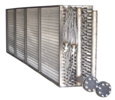Is stainless steel the best material for your steam coils?

If you haven’t thought about using stainless steel for your steam coils, you should. It’s even better than the typical tube-fin combination of copper-aluminum in some HVAC systems.
When choosing materials for your steam coils, there are a number of things to consider:
- Is the steam or liquid that travels through the coils corrosive?
- Is anything in the external environment that is corrosive?
- What steam pressure is needed?
- What heat transfer level is needed?
- What are the piping, trapping and venting needs?
- Are there specific installation and service requirements?
When you are dealing with harsh or corrosive settings, especially where leaking coils can be dangerous, consider using stainless steel. Unlike copper and aluminum, stainless steel is resistant to corrosion. Stainless steel is also a smart choice for certain industries, including chemical, food & beverage, oil & gas, and pharmaceutical.
Because salt is corrosive, having steam coils made of stainless steel in areas near the ocean makes sense. Another benefit of using stainless steel is that it can handle high steam pressure. Stainless steel steam coils are durable and have high tensile strength.
Regular maintenance of your steam coils should include: inspection of condensate traps, vacuum breakers, air vents and valve; draining and flushing of the condensate drip legs and sediment traps; and analysis of boiler water.
Emergent Coils provides steam coils to meet your exact specifications, often at a fraction of the cost of steam coils ordered through the original equipment manufacturer (OEM). Our coils come with a variety of tube, fin and material options.
If you need help selecting the best material for your steam coils, give our coil specialists a call at 1-855-Coil-Now or email us at sales@emergentcoils.com today.
